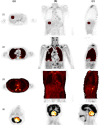Quantitative accuracy of attenuation correction in the Philips Ingenuity TF whole-body PET/MR system: a direct comparison with transmission-based attenuation correction
- PMID: 22923020
- PMCID: PMC3572377
- DOI: 10.1007/s10334-012-0328-5
Quantitative accuracy of attenuation correction in the Philips Ingenuity TF whole-body PET/MR system: a direct comparison with transmission-based attenuation correction
Erratum in
- MAGMA. 2015 Feb;28(1):101
Abstract
Objective: Evaluation of the quantitative accuracy of MR-based attenuation correction (MRAC) in the Philips Ingenuity TF whole-body PET/MR.
Materials and methods: In 13 patients, PET emission data from the PET/MR were reconstructed using two different methods for attenuation correction. In the first reconstruction, the vendor-provided standard MRAC was used. In the second reconstruction, a coregistered transmission-based attenuation map from a second immediately preceding investigation with a stand-alone Siemens ECAT EXACT HR(+) PET scanner was used (TRAC). The two attenuation maps were compared regarding occurrence of segmentation artifacts in the MRAC procedure. Standard uptake values (SUVs) of multiple VOIs (liver, cerebellum, hot focal structures at various locations in the trunk) were compared between both reconstructed data sets. Furthermore, a voxel-wise intensity correlation analysis of both data sets in the lung and trunk was performed.
Results: VOI averaged SUV differences between MRAC and TRAC were as follows (relative differences, mean ± standard deviation): (+12 ± 6) % cerebellum, (-4 ± 9) % liver, (-2 ± 11) % hot focal structures. The fitted slopes of the voxel-wise correlations in the lung and trunk were 0.87 ± 0.17 and 0.95 ± 0.10 with averaged adjusted R (2) values of 0.96 and 0.98, respectively. These figures include two instances with partially erroneous lung segmentation due to artifacts in the underlying MR images.
Conclusion: The MR-based attenuation correction implemented on the Philips Ingenuity PET/MR provides reasonable quantitative accuracy. On average, deviations from TRAC-based results are small (on the order of 10% or below) across the trunk, but due to interindividual variability of the segmentation quality, deviations of more than 20% can occur. Future improvement of the segmentation quality would help to increase the quantitation accuracy further and to reduce the inter-subject variability.
Figures








References
Publication types
MeSH terms
LinkOut - more resources
Full Text Sources
Medical
Miscellaneous

